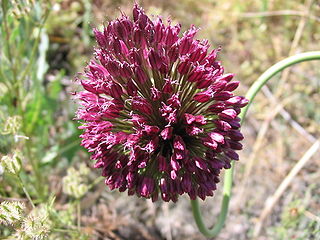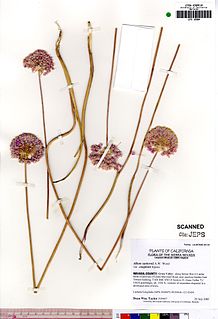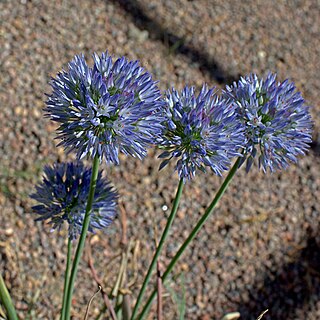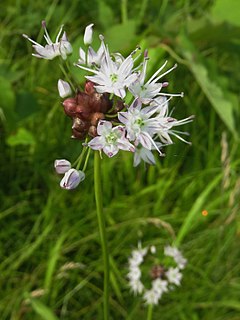
Chives, scientific name Allium schoenoprasum, is a species of flowering plant in the family Amaryllidaceae that produces edible leaves and flowers. Their close relatives include the common onions, garlic, shallot, leek, scallion, and Chinese onion.

Allium sphaerocephalon is a plant species in the Amaryllis family known as round-headed leek, round-headed garlic, ball-head onion, and other variations on these names. Drumstick allium is another common name applied to this species. Some publications use the alternate spelling Allium sphaerocephalum. It is a bulbous herbaceous perennial plant.

Allium anceps, known as twinleaf onion and Kellogg's onion, is a species of wild onion native to the western United States. It is widespread in Nevada, extending into adjacent parts of California, Idaho, and Oregon. It grows in barren clay and rocky soils.

Allium monanthum, the Korean wild chive, is a spring vegetable with minuscule bulbous roots that have a mild onion flavor and found in the woodlands of Korea, Japan, northeastern Russia (Primorye), and northeastern China.

Allium nigrum, common name black garlic, broad-leaved leek, or broadleaf garlic, is a Middle Eastern species of wild onion. It lacks the onion or garlic scent shared by most of the other species in the group. The species is native to Turkey, Cyprus, Syria, Lebanon, and Israel but cultivated as an ornamental in many other places. It has become naturalized in some regions, including parts of the United States.

Allium platycaule is a species of wild onion known as broadstemmed onion or flat-stem onion. It is native to northeastern California, south-central Oregon and northwestern Nevada. It is found on slopes of elevations of 1500–2500 m.

Allium burlewii is a species of wild onion known by the common name Burlew's onion. It is endemic to California, where grows in the granitic soils of several of the central and southern mountain ranges from Riverside and San Bernardino to Fresno and Monterey Counties, usually between 6,000 and 10,000 feet above sea level.

Allium praecox is a species of wild onion known by the common name early onion.

Allium sanbornii is a North American species of wild onion known by the common name Sanborn's onion. It is native to northern California and southwestern Oregon. It grows in the serpentine soils of the southern Cascade Range and northern Sierra Nevada foothills.

Allium tolmiei is a plant species native to Idaho, eastern and central Oregon, southeastern Washington, northwestern Nevada and northeastern California. It occurs on mountains and scrublands at elevations of 1,300–9,200 feet (400–2,800 m). It was discovered by and named for Dr. William Fraser Tolmie.

Allium caesium, light blue garlic, is a species of herbaceous perennial flowering plant native to central Asia. It grows in deserts and dry fields at elevations of 700–2,000 m (2,300–6,600 ft).
Allium flavidum is an Asian species of onions native to Xinjiang, Altay Krai, Mongolia and Kazakhstan. It grows in rocky areas.

Allium lineare is a Eurasian species of wild onions with a wide range extending from France to Mongolia.

Allium macrostemon, Chinese garlic, Japanese garlic or long-stamen onion, is a species of wild onion widespread across much of East Asia. It is known from many parts of China, as well as Japan, Korea, Mongolia, Tibet and Primorye. It has been collected from elevations ranging from sea level to 3000 m.

Allium mairei is an Asian species of wild onion in the Amaryllis family. It is native to Sichuan, Tibet, Yunnan, Myanmar, and Arunachal Pradesh.

Allium obliquum, common name lop-sided onion or twisted-leaf onion, is a Eurasian species of wild onion with a range extending from Romania to Mongolia. It is also widely cultivated elsewhere as an ornamental.
Allium platyspathum is an Asian species of wild onion. It has been reported from Xinjiang, Afghanistan, Kazakhstan, Kyrgyzstan, Mongolia, Altay Krai, Tajikistan, Uzbekistan, and Pakistan. It grows in damp locations at elevations of 1900–3700 m.
Allium polyrhizum is a species of wild onion widespread across Zabaykalsky Krai, Kazakhstan, Mongolia, and China at elevations 1000–3700 m.
Allium tubiflorum is a plant species native to China at elevations less than 2000 m.

Allium tulipifolium is an Asian species of wild onion native to Xinjiang, Kazakhstan and Altay Krai. It is found at elevations of 600–1000 m.
















